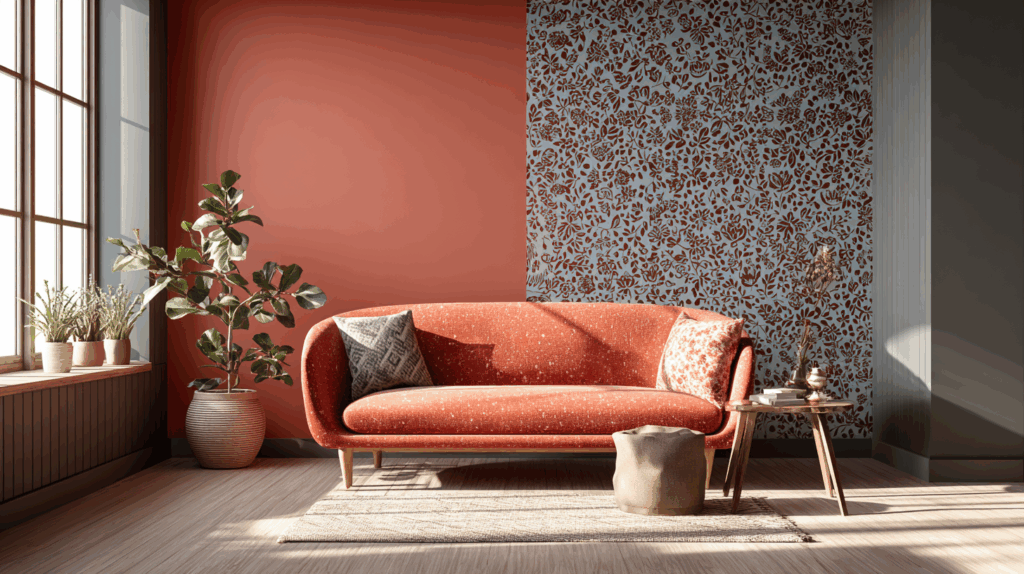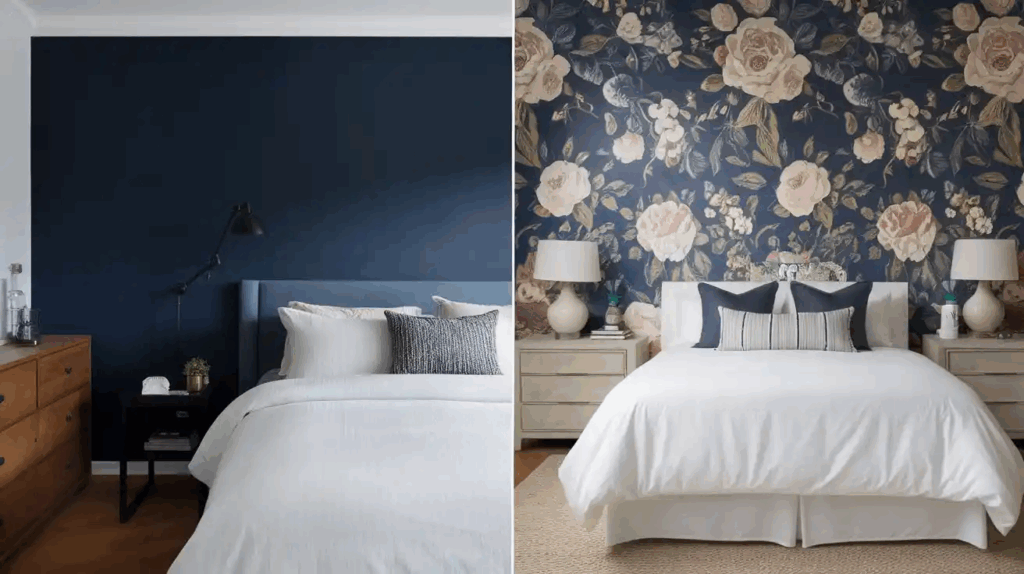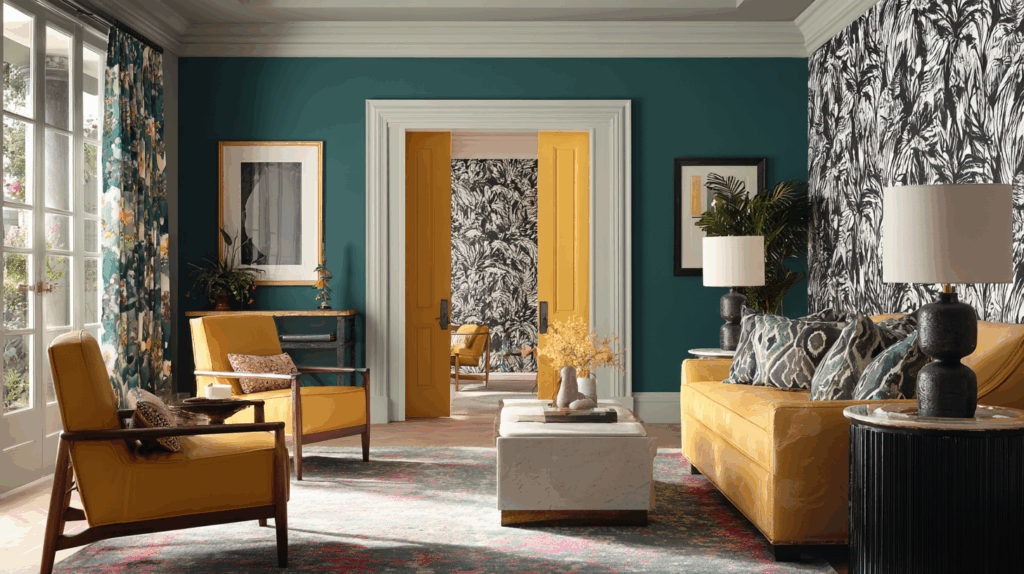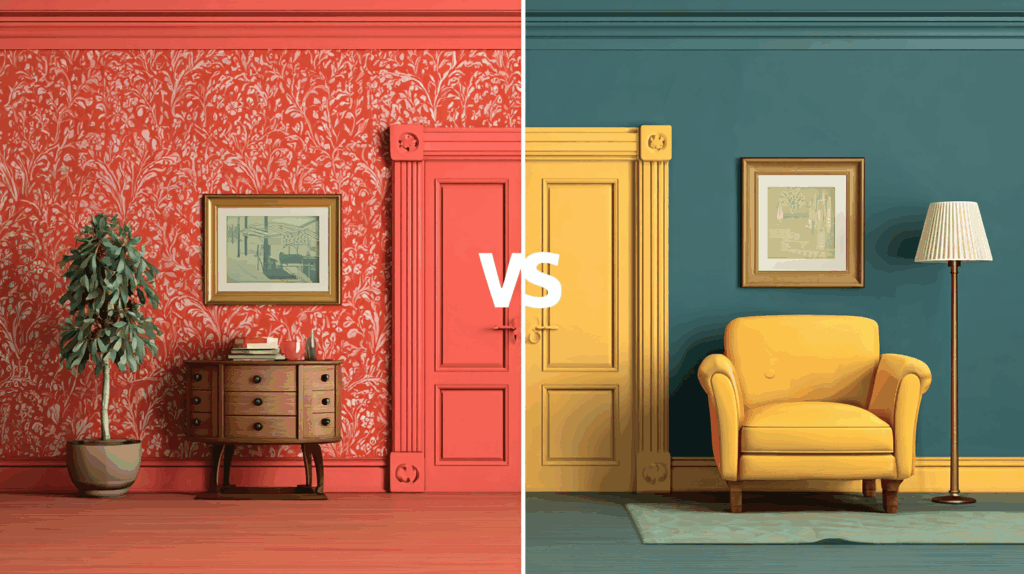I remember standing in my living room, staring at that giant blank wall, trying to decide if I should use paint or wallpaper.
I’d used paint before, but wallpaper had all these cool textures and patterns I couldn’t stop thinking about.
If you’re in the same boat, stuck scrolling through ideas and second-guessing, you’re not alone.
In this guide, I’ll share what I learned and the stuff I wish someone had told me sooner.
From design and durability to cost, installation, and even the DIY-versus-pro debate, I’ve got you covered.
Redoing just one wall or going all in? This will help you figure out what actually fits your space and your style.
Understanding Wallpaper and Paint

Wallpaper is a decorative paper or vinyl that you stick to your walls. It comes in patterns, colors, textures, and even murals. Some types peel off easily while others are made to last for years.
Paint is liquid color applied with a brush or roller. It dries to cover your walls with a smooth or textured finish. You can choose from finishes like matte, satin, or gloss, depending on the look and durability you want.
This choice matters because it’s not just about looks. It affects how your space feels, how often you’ll need to touch things up, and how much effort you’re willing to put in.
Choosing the right one can save you time, money, and stress in the long run.
Wallpaper vs Paint: A Side-by-Side Comparison
Before going into the pros and cons, a quick side-by-side comparison of wallpaper and paint offers the highlights up front if you’re short on time or just want a quick overview.
| Feature | Wallpaper | Paint |
|---|---|---|
| Design Options | Bold, patterned, textured | Unlimited colors and finishes |
| Durability | 10–15 years, may peel in humidity | 5–10 years, touch-up friendly |
| Ease of Use | Harder to install/remove; often needs a pro | DIY-friendly, quick to apply |
| Maintenance | Wipeable if vinyl, but harder to repair | Easy to clean and repaint |
| Best For | Bedrooms, feature walls, and low-traffic areas | Kitchens, bathrooms, kids’ rooms, full coverage |
| Cost | Higher upfront, longer lifespan | Cheaper upfront, more frequent reapplication |
| Visual Impact | Stylish and dramatic | Flexible and subtle |
These aren’t hard rules, but they give you a solid starting point. Now let’s walk through each difference in more detail.
Wallpaper vs Paint: Design and Style Differences
When it comes to visual style, wallpaper vs paint is a choice between instant personality and endless flexibility.
Wallpaper brings ready-made patterns, textures, and bold designs to your space, perfect if you want something dramatic or detailed.
Paint, on the other hand, gives you unlimited color choices. Want eggshell blue? Done. Matte black? No problem.
You can mix custom shades and choose different finishes like flat, satin, or glossy. It’s perfect when you want a simple look or a custom palette.
Where wallpaper works best
- Accent walls
- Bedrooms or powder rooms
- Making a space feel cozy or dramatic
Where Paint Works Best
- Whole-room updates
- Quick refreshes
- Matching trim and ceiling
Wallpaper adds style and texture, while paint gives you flexibility and ease. Both can work beautifully depending on your space and needs. Pick what fits your vision, budget, and how often you plan to update.
Which One Wins?
Wallpaper wins for big style statements. Paint wins if you want subtle, flexible looks that are easier to switch up.
Wallpaper vs Paint: Which Lasts Longer?
If you’re thinking long term, wallpaper vs paint boils down to durability versus adaptability.
Wallpaper can last 10 to 15 years without fading or needing a refresh, but it may peel or bubble in humid rooms.
Paint typically lasts 5 to 10 years, depending on the finish, but it’s easier to touch up and repaint.
One holds its look longer, the other is easier to maintain over time.
Consider this:
- Kids and pets might scratch the wallpaper
- Moisture can make paint bubble or fade
- Wallpaper resists scuffs but is hard to repair if damaged
For long-term use in calm, dry spaces, wallpaper holds up better. But for active homes with pets or kids, paint is easier to maintain and repair.
Cost Breakdown: Wallpaper vs Paint
When deciding between wallpaper and paint, cost is more than just what you pay upfront. It’s also about how long each option lasts, how often you’ll need to update it, and how much effort or help is required.
| Cost Factor | Wallpaper | Paint |
|---|---|---|
| Materials | $150–$500 | $50–$150 |
| Installation/Labor | $150–$300 (pro recommended) | $50–$150 (easy to DIY) |
| Total Cost | $300–$800 | $100–$300 |
| Lifespan | 10–15 years | 5–10 years |
| Reapplication Cost | Less frequent, higher repair cost | More frequent, low-cost touch-ups |
Paint wins for budget-friendly projects and quick updates. Wallpaper costs more upfront, but can save you money in the long run if you’re not planning frequent changes.
Wallpaper vs Paint: Which Is Easier to Apply or Remove?

Between wallpaper vs paint, the easier one really depends on your patience and tools.
Paint is generally more beginner-friendly. You can roll it on in a day, fix mistakes fast, and start over with little fuss.
Wallpaper takes longer and demands precision. It’s harder to fix errors, and removal later can be messy.
Still, the payoff in style might be worth the extra work for some.
Paint is easier for beginners. If you’re short on time or don’t want to hire a pro, it’s the simpler choice.
Wallpaper vs Paint: Best Choice by Room Type
Not every wall sees the same wear and tear. Some spaces deal with moisture, daily messes, or constant activity. Choosing between wallpaper and paint depends a lot on where you’re applying it.
| Room Type | Wallpaper | Paint |
|---|---|---|
| Kitchens & Bathrooms | Use only vinyl or moisture-safe types. Can be peeled in humid areas. | Handles humidity well. Choose semi-gloss or mildew-resistant formulas. |
| Living Rooms & Bedrooms | Adds warmth, texture, and visual interest. Great for feature walls. | Offers a clean, calm finish. Easy to refresh or repaint when needed. |
| Hallways & Kids’ Rooms | Choose washable types. Avoid delicate textures. | Gloss or satin finishes are easy to clean and maintain. Durable for high-traffic. |
Paint is the more reliable choice in kitchens, bathrooms, and high-traffic areas thanks to its moisture resistance and easy clean-up. Wallpaper shines in bedrooms, offices, or feature walls where you want style without constant wear.
Wallpaper vs Paint: What’s Easier to Clean and Maintain?
When comparing wallpaper vs paint for upkeep, it all comes down to the finish and the room.
- Wallpaper Maintenance: Vinyl wallpaper is easy to wipe down, but seams may lift over time, and tears are tough to fix. It requires careful attention, especially in high-traffic areas.
- Paint Maintenance: Paint, particularly in satin or gloss finishes, offers easy cleaning. Touch-ups are simple, making it a low-maintenance option.
For low-effort upkeep, paint generally takes the lead. However, if you use durable, washable wallpaper types in low-traffic rooms, you won’t have to worry about frequent scrubbing.
In the end, paint is ideal for low-maintenance homes, but the right wallpaper can still be effective if placed in the right rooms.
When to Use Both Paint and Wallpaper (Hybrid Approach)

A hybrid approach, using both paint and wallpaper, can be a great solution when you want the best of both worlds.
- Accent Walls: Wallpaper can make a statement on one wall, while paint covers the rest of the room. This works well for creating a focal point without overwhelming the space.
- High-Traffic Areas: Use paint in areas that get a lot of use, like hallways or staircases, while wallpaper can be added to lower-traffic spots, like behind a bed or in a dining room.
- Different Textures: Combine wallpaper with a painted trim or ceiling to add texture and dimension. This creates a balanced look while keeping things visually interesting.
Using both allows you to mix durability and beauty, giving your space personality while keeping it easy to maintain
DIY vs Professional: A Quick Guide for Wallpaper and Paint
I’ve tackled both wallpaper and paint on my own, and I’ve also called in professionals when things got tricky.
Each option has its own learning curve, but some are more beginner-friendly than others.
Paint is usually easier to DIY. If you have time, patience, and don’t mind using painter’s tape or drop cloths, you can likely manage it yourself.
Small flaws like roller marks or uneven edges are common but easy to fix or paint over later.
Wallpaper tends to be more challenging, especially if it’s textured, patterned, or your walls are not completely smooth. In those cases, hiring a professional might be the smarter move.
Some common mistakes include skipping primer before painting, leaving visible brush strokes, or dealing with wallpaper bubbles, peeling corners, and mismatched seams.
If you’re careful and take your time, both can be done solo. But if it feels like too much, bringing in help can save you a lot of stress.
Final Verdict: What Should You Choose?
So, what should you choose – wallpaper or paint?
There’s no one-size-fits-all answer. It depends on a few factors.
If you’re on a tight budget, paint is usually cheaper upfront. However, wallpaper can save money in the long run because it tends to last longer.
Consider your lifestyle too. For homes with pets, kids, or heavy foot traffic, durability and easy cleaning matter.
Your style preferences also play a role. Wallpaper offers bold patterns and texture, while paint allows flexibility with soft colors and frequent updates.
Finally, paint is easier for DIY, but wallpaper may require more skill or professional help.
Now that you know the pros and cons, you’re ready to decide what fits your space best.

